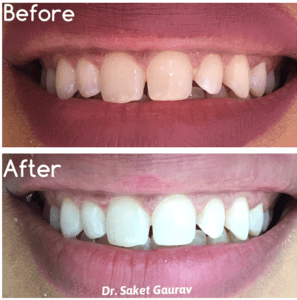Receding gums
Dr.Saket Gaurav
B.D.S.(India), PGD.Ortho, PGDAD(Cosmetic)
International Dental Practitioner
DENTAL MAKEOVER, Delhi NCR.
Gum recession is a common dental problem that occurs gradually, so most people don’t realize they have it. It is the process in which the margin of the gum tissue that surrounds the teeth wears away or pulls back, exposing more of the tooth or the tooth’s root. When it occurs pocket or gaps are formed between the gum line, which makes it easy for disease causing bacteria to damage the tooth. The first sign of gum recession is usually tooth sensitivity, or you may notice your tooth looks longer than normal.
Reasons for receding gums
- Aggressive brushing techniques- By brushing your teeth too vigorously, you can wear away the enamel on your teeth, and your gums will start to recede. Always use a soft or extra soft toothbrush and be gentle but thorough.
- Tobacco products- People who chew or smoke tobacco are more likely to develop sticky plaque on their teeth which is hard to remove so therefore can lead to gum disease. The chemicals also damage all of the soft tissues in the mouth and leads to receding gums.
- Gum diseases-Bacterial gum infections like periodontal disease destroy the gum tissue and the supporting bone that holds your teeth in place. These diseases cause gum recession.
- Insufficient dental care-Inadequate brushing and flossing habits will lead to excessive accumulations of plaque and tartar on and between your teeth. The buildup of plaque and tartar irritates the gums and can cause them to recede.
- Teeth grinding and/or clenching- By putting too much unnecessary force on your teeth you can cause the gums to recede.
- Genetics-Some people are simply more susceptible to gum disease. Therefore, even if you are a diligent brusher and flosser, you may be predisposed to gum disease, which leads to receding gums.
- Crooked teeth or a misaligned bite-It can be much harder to keep crooked teeth clean. A misaligned bite can cause a person to put excessive forces on some teeth and minimal forces on others. Both can lead to gum recessions.
- Lip or tongue piercings-Body jewellery can rub against your gums, which can irritate them and wear away the gum tissue.
- Hormonal changes-For women who experience hormonal fluctuations, especially during pregnancy or menopause, their gums can become more inflamed and hence more vulnerable to receding gums.
- Accelerated orthodontic treatment -By moving the teeth too quickly during an orthodontic treatment, the gums can start to recede, due to the body’s inability to adjust to rapid tooth movement.
Gum recession Treatment
For mild gum recession, your dentist can perform a deep cleaning also known as tooth scaling and root planning on the affected area. This procedure removes plaque and tartar that has built up on the teeth and root surfaces below the gum line. Then the exposed root area is smoothed to make it more difficult for bacteria to attach on the tooth surface. Sometimes antibiotics may be prescribed to get rid of any remaining harmful bacteria. If you have excess bone loss, then you may require gum surgery and tissue grafts to repair the damage caused by gum recession.
How to prevent gum recession
The best way to prevent gum recession is to take good care of your teeth by brushing and flossing every day and visiting your dentist every six months. If you are experiencing gum recession, your dentist may want to see you more often. Also, always use a soft-bristled toothbrush and ask your dentist to demonstrate the proper brushing technique. If you have misaligned teeth, or if you grind your teeth, discuss treatment options with your dentist. Lastly, quit smoking if you are a smoker and eat a well-balanced diet. By following these simple guidelines, you’ll enjoy a healthy smile for years to come.

